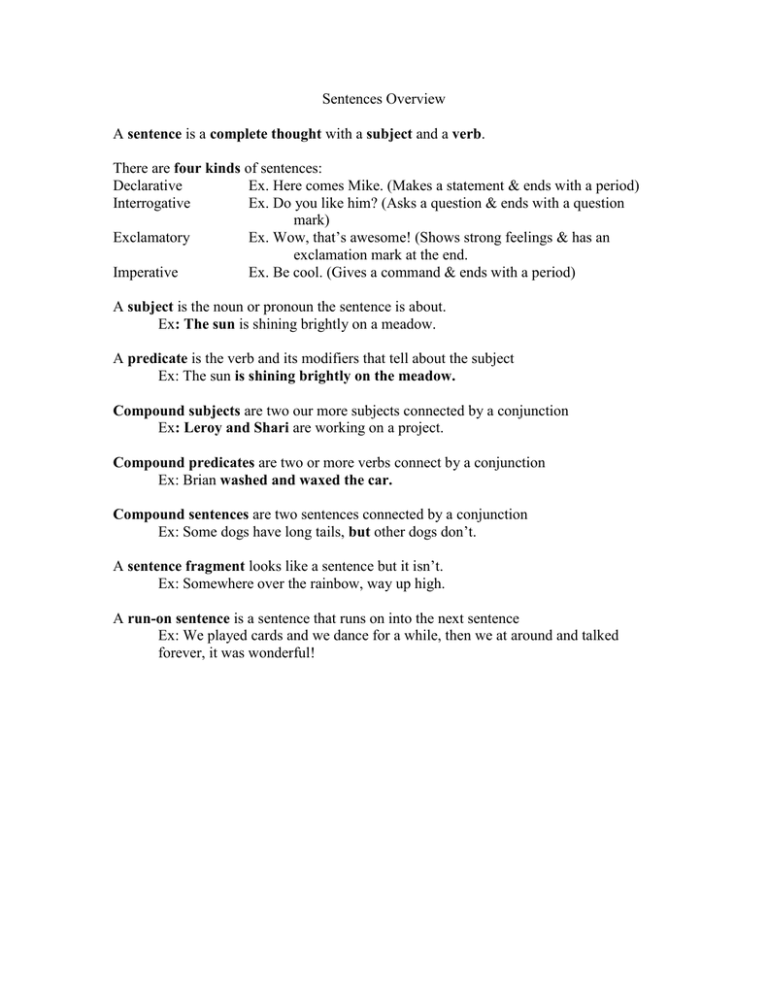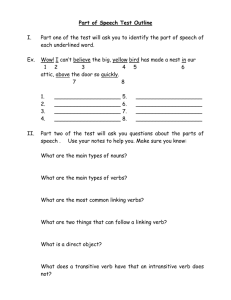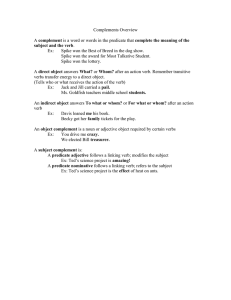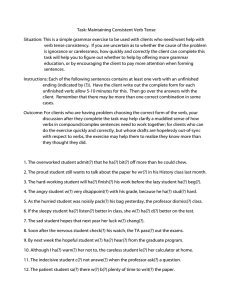Sentences Overview sentence four kinds
advertisement

Sentences Overview A sentence is a complete thought with a subject and a verb. There are four kinds of sentences: Declarative Ex. Here comes Mike. (Makes a statement & ends with a period) Interrogative Ex. Do you like him? (Asks a question & ends with a question mark) Exclamatory Ex. Wow, that’s awesome! (Shows strong feelings & has an exclamation mark at the end. Imperative Ex. Be cool. (Gives a command & ends with a period) A subject is the noun or pronoun the sentence is about. Ex: The sun is shining brightly on a meadow. A predicate is the verb and its modifiers that tell about the subject Ex: The sun is shining brightly on the meadow. Compound subjects are two our more subjects connected by a conjunction Ex: Leroy and Shari are working on a project. Compound predicates are two or more verbs connect by a conjunction Ex: Brian washed and waxed the car. Compound sentences are two sentences connected by a conjunction Ex: Some dogs have long tails, but other dogs don’t. A sentence fragment looks like a sentence but it isn’t. Ex: Somewhere over the rainbow, way up high. A run-on sentence is a sentence that runs on into the next sentence Ex: We played cards and we dance for a while, then we at around and talked forever, it was wonderful! More on Subjects, Predicates, and Complements Holt Handbook, Chapter 2: The Parts of a Sentence (34-60) SUBJECT A simple subject is a word or word group that tells whom or what the sentence is about. A complete subject consists of the simple subject and any words or word groups that modify the simple subject (39). Example: A dog with this pedigree is usually nervous. ***** Note: The subject of a sentence is NEVER in a prepositional phrase! A prepositional phrase consists of a preposition, the object of a preposition and any modifiers of that object (24). Commonly used prepositions: after, as, at, before, but (meaning except), during, for, like, of, since, to, until, with, without Commonly used compound prepositions: according to, because of, in addition to, in front of, in spite of, instead of, on account of, prior to, such as Examples of prepositional phrases: For the team, of min, through the years, on the top shelf, at all times, along with my niece ***** A compound subject combines two subjects with a conjunction. PREDICATE The simple predicate, or verb, is the main word or word group (verb phrase: verb + helping verb/s) that tells something about the subject. List of commonly used helping verbs: am, are, can, could, did, do, does, had, has, have, is, may, might, must, shall, should, was, were, will, would The complete predicate consists of the verb and all the words that modify the verb and complete its meaning (39). COMPLEMENTS Subject Complements Subject complements complete the meaning/s of linking verbs only (48). ***** Tip: To determine whether a verb in a sentence is linking, substitute a form a form of the verb to be for the verb. If the sentence makes sense, the verb is most likely linking (17)! Common forms of the verb to be: be, being, am, is, are, was, were, shall be, will be, has been , have been, had been, shall have been, will have been, can be, may be, might be, must be, should be, would be, could be, should have been, would have been, could have been Other linking verbs: appear, become, fell, grow, look, remain, seem, smell, sound, stay, taste, turn ***** There are two types of subject complements: predicate nominatives and predicate adjectives. A predicate nominative is a complement in the form of a noun or pronoun that follows a linking verb and modifies the subject by identifying it or referring to it. Example: Some caterpillars become butterflies. The noun “butterflies” follows the linking verb become and identifies the subject caterpillars. A predicate adjective is a complement in the form of an adjective that follows a linking verb and modifies the subject by describing it. Example: You look happy. The adjective “happy” follows the linking verb look and describes the subject you. Object Complements The object of a verb is a complement that, unlike a subject complement, does not identify or modify the subject. An object of a verb is noun, pronoun or word group that completes the meaning of a transitive verb (53). ***** Transitive Verb: A verb that expresses action directed toward a person, place thing or idea (noun or pronoun). A transitive verb always has an object or a word that tells who or what receives the action of the verb (19). Example: The cat was chasing a moth. The noun “moth” completes the meaning of the verb chasing. Note: Action verbs can be transitive or intransitive but intransitive verbs are verbs that do not have objects. All linking verbs are intransitive! ***** Direct object: answers Whom? Or What? after an action verb. Refer to the example above. Chasing what? A moth. Indirect object: answers To what or whom? or For what or whom? after an action verb. Example: Jeff’s mother gave him some grapes. Again, the direct object (in this case, grapes) answers what Jeff’s mother gave. To whom did Jeff’s mother give? him = the indirect object. Complements Overview A complement is a word or words in the predicate that complete the meaning of the subject and the verb. Ex: Spike won the Best of Breed in the dog show. Spike won the award for Most talkative Student. Spike won the lottery. A direct object answers What? or Whom? after an action verb. (Tells who or what receives the action of the verb) Ex: Jack and Jill carried a pail. Ms. Goldfish teachers middle school students. An indirect object answers To what or whom? or For what or whom? after an action verb Ex: Davis loaned me his book. Becky got her family tickets for the play. An object complement is a noun or adjective object required by certain verbs Ex: You drive me crazy. We elected Bill treasurer. A subject complement is: A predicate adjective follows a linking verb; modifies the subject Ex: Ted’s science project is amazing! A predicate nominative follows a linking verb; refers to the subject Ex: Ted’s science project is the effect of heat on ants. Sentences Classified According to Structure Holt Handbook pp.102-103 A sentence can be classified, depending on its structure, as simple, compound, complex or compound-complex. Simple Sentences contain one independent clause and no subordinate clauses. A simple sentence may contain a compound subject, a compound verb and any number of phrases. Example: Cora and Kareem bought party supplies at the mall. (compound subject) Later, they drove to school and decorated the cafeteria for the Ecology Club’s annual banquet. (compound verb) Compound Sentences contain two or more independent clauses and no subordinate clauses. A compound sentence is two or more independent clauses joined together by (1) a comma and a coordinating conjunction, (2) a semi-colon, or (3) a semicolon and a conjunctive adverb such as therefore, however, or consequently followed by a comma. Example: Cora hung colorful streamers from the ceiling, and Kareem set party favors on the tables. Complex sentences contain one independent clause and at least one subordinate clause. Example: When they had finished their work, they complimented each other on the results. (Underline the independent clause, then circle the subordinate clause) Compound-complex sentences contain two or more independent clauses and at least one subordinate clause. Example: Cora waited for just the right moment to ask Kareem to the banquet, and he promptly accepted her invitation, adding that he had been planning to ask her. (Underline the independent clauses, then circle the subordinate clause/s) Style Tip: Paragraphs with repetitive sentence structure (esp. simple) can be monotnous to read. Draw your readers in by varying your sentence structure, and add meaningful variation that calls attention to your purpose! Computer Tip: By inserting a return or a page break after every period, you can easily view the sentences in a vertical list and compare the structures of each sentence! Then, make your revisions for accuracy and style!







